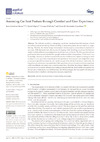Identificador persistente para citar o vincular este elemento:
https://accedacris.ulpgc.es/jspui/handle/10553/114370
| Campo DC | Valor | idioma |
|---|---|---|
| dc.contributor.author | Caballero Bruno, Irene | en_US |
| dc.contributor.author | Töpfer, Daniel | en_US |
| dc.contributor.author | Wohllebe, Thomas | en_US |
| dc.contributor.author | Hernández Castellano, Pedro Manuel | en_US |
| dc.date.accessioned | 2022-04-18T10:05:08Z | - |
| dc.date.available | 2022-04-18T10:05:08Z | - |
| dc.date.issued | 2022 | en_US |
| dc.identifier.issn | 2076-3417 | en_US |
| dc.identifier.other | Scopus | - |
| dc.identifier.uri | https://accedacris.ulpgc.es/handle/10553/114370 | - |
| dc.description.abstract | The vehicular market is undergoing a profound transformation that includes a trend toward fully automated driving. When travelling in automated systems, the main task is no longer driving. Therefore, the interior design of automated vehicles requires a renovation to adapt to new use cases. With this motivation, the use case of sleeping while travelling was chosen for this user study, in which different seat configuration conditions were evaluated. The three preselected seat positions for this research included the upright, reclined and flat seat positions. To the best of our knowledge, this study is the first to examine the comfort of different seat angles in meeting the need to sleep in a moving vehicle. Since the physical experience of the occupants with a high-fidelity seat prototype is essential to evaluate the new interior concept of the vehicle of the future, in this study, the experimental participants were asked about their perception of comfort and overall user experience while travelling by car under close-to-real test conditions. Therefore, the primary objective of this evaluation was to explore different seat configurations and find the most suitable seat position for the use case of sleeping in a car while moving. Our findings suggest that users prefer reclining and flat seats in short-/medium-and long-term use cases, respectively. | en_US |
| dc.language | eng | en_US |
| dc.relation.ispartof | Applied Sciences (Basel) | en_US |
| dc.source | Applied Sciences (Switzerland) [EISSN 2076-3417], v. 12 (7), (Abril 2022) | en_US |
| dc.subject | 3317 Tecnología de vehículos de motor | en_US |
| dc.subject | 331707 Accesorios y recambios | en_US |
| dc.subject.other | Car Seat | en_US |
| dc.subject.other | Comfort | en_US |
| dc.subject.other | Seat Angles | en_US |
| dc.subject.other | Testing | en_US |
| dc.subject.other | User Experience | en_US |
| dc.title | Assessing Car Seat Posture through Comfort and User Experience | en_US |
| dc.type | info:eu-repo/semantics/article | en_US |
| dc.type | Article | en_US |
| dc.identifier.doi | 10.3390/app12073376 | en_US |
| dc.identifier.scopus | 85127596824 | - |
| dc.contributor.orcid | NO DATA | - |
| dc.contributor.orcid | NO DATA | - |
| dc.contributor.orcid | NO DATA | - |
| dc.contributor.orcid | NO DATA | - |
| dc.contributor.authorscopusid | 57561442200 | - |
| dc.contributor.authorscopusid | 56044067000 | - |
| dc.contributor.authorscopusid | 57562405900 | - |
| dc.contributor.authorscopusid | 57562406000 | - |
| dc.identifier.eissn | 2076-3417 | - |
| dc.identifier.issue | 7 | - |
| dc.relation.volume | 12 | en_US |
| dc.investigacion | Ingeniería y Arquitectura | en_US |
| dc.type2 | Artículo | en_US |
| dc.utils.revision | Sí | en_US |
| dc.date.coverdate | Abril 2022 | en_US |
| dc.identifier.ulpgc | Sí | en_US |
| dc.contributor.buulpgc | BU-ING | en_US |
| dc.description.sjr | 0,492 | |
| dc.description.jcr | 2,7 | |
| dc.description.sjrq | Q2 | |
| dc.description.jcrq | Q2 | |
| dc.description.scie | SCIE | |
| dc.description.miaricds | 10,5 | |
| item.fulltext | Con texto completo | - |
| item.grantfulltext | open | - |
| crisitem.author.dept | GIR Fabricación integrada y avanzada | - |
| crisitem.author.dept | Departamento de Ingeniería Mecánica | - |
| crisitem.author.orcid | 0000-0001-8443-118X | - |
| crisitem.author.parentorg | Departamento de Ingeniería Mecánica | - |
| crisitem.author.fullName | Caballero Bruno, Irene | - |
| crisitem.author.fullName | Hernández Castellano, Pedro Manuel | - |
| Colección: | Artículos | |
Citas SCOPUSTM
14
actualizado el 08-jun-2025
Citas de WEB OF SCIENCETM
Citations
11
actualizado el 08-jun-2025
Visitas
157
actualizado el 31-may-2025
Descargas
75
actualizado el 31-may-2025
Google ScholarTM
Verifica
Altmetric
Comparte
Exporta metadatos
Los elementos en ULPGC accedaCRIS están protegidos por derechos de autor con todos los derechos reservados, a menos que se indique lo contrario.
